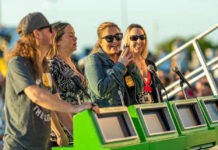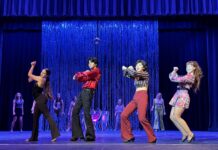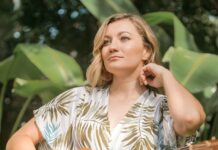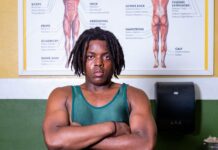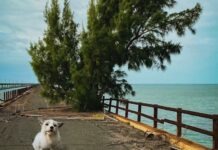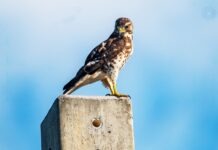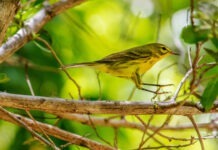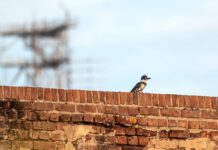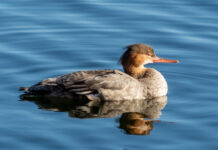A Palm Warbler in breeding season tends to glow up. The streaks that line the breast and belly sharpen and get more distinct. The breast itself brightens to a yellow closer to that of a freshly painted school bus. The rufous cap on the crown of its head gets rufouser.
You see them that way sometimes, but usually briefly, late in the spring, when they are about to head north to find a spruce-lined bog and hatch some eggs. But mostly in the Keys, where they live from September to late March, you see them in their non-breeding plumage, which is duller and far less distinct – the avian equivalent of a housecoat and curlers.
The thing about palm warblers is you don’t need to know anything about their plumage to identify them. They are given away by their telltale tail twitch. (Say it five times fast.) Sometimes their tails twitch in a constant meter, like they’re bouncing an invisible ball. Sometimes the twitch is arrhythmic and seemingly random. But it’s never more than five or so seconds between twitches.
No one knows why they twitch their tails like this. What is the point of a creature evolving with a compulsive, possibly autonomic, behavior that burns energy and, to the human eye at least, serves no purpose? There are other birds with similar seemingly autonomic bodily motions – Louisiana waterthrushes and spotted sandpipers, for instance. The one thing these birds have in common is they all breed, or spend most of their time, near water. Some have theorized that the tail bopping and the body rocking mimics the rhythm of moving water, and is possibly a form of camouflage. But it’s a theory that’s never felt right to me. If it’s a motion that draws my eye, how could it make things more difficult for a predator’s eye?
The why’s of all this are something I’m pretty sure will never be answered. How do you ask a bird why it does what it does? How many of our own actions are a mystery to ourselves?
But the question flashes across my brain, pretty much every time I see a palm warbler, though that flash may not last much longer than a tail twitch.
I spent a lot of time watching palm warblers, and having little flashes, this weekend, not that I was seeking them out. (They’re probably the most common songbird in the Keys in winter. They are the opposite of hard to find.) But I was at the Key West Literary Seminar, which was held for the second year at the Coffee Butler Amphitheater, and there was a small group – never more than three birds – that kept flitting in and out of the audience. They’d land on the chair, then on the guy wires for the tent, then on the stage, the speaker stand, the microphone, and the chair again. Then they’d flit off, only to return a few minutes later to start jumping around on things again in a different order. They’d get close to people, but not so close they could get grabbed. (They know how fast they are.)
Meanwhile, on stage, great writers were saying great things. The theme this year was, “Singing America: A Celebration of Black Literature.” (Full disclosure: my wife is president of the KWLS board.)
I was a little trepidatious about what might get said with a cast of Black authors in front of a predominantly white audience, but the most awkward it got was when a women in the audience recalled reading “Little Black Sambo” when she was a child in the 1930s, and wanted to know if that book was considered racist. Everyone on stage, and about half the audience, gave a very fast, “Yes!” Someone, I believe the novelist Deesha Philyaw, added, “And so was the restaurant!” And everyone moved on to more interesting things without missing a beat.
Mostly the weekend was a rolling cavalcade of accomplished speakers and readers. I wasn’t taking notes, but I can remember so many things that just resonated. Tananarive Due, who landed a day late after a delayed west coast red eye, got rushed to the stage, and gave a mind bogglingly warm and erudite 45-minute disquisition on Afrofuturism. Tayari Jones, who talked about finding inspiration while eavesdropping at a mall food court, and who hilariously described being at a reading once and having an old woman threaten her with her cane because Jones’s last novel did not conform to certain expected narrative tropes.
S.A. Cosby, a writer I admire to no end – read “Blacktop Wasteland” if you haven’t – whose hard driving thrillers can tell you more about race in America than any 10-foot stack of scholarly papers, conveyed a deep appreciation for the success he’s found in recent years, as well as a love for the broad array of other writers and artists who inspired him to get there.
Nadege Green brought her Miami cool as a light touch moderator. Rowan Ricardo Phillips, Kevin Young, Jericho Brown, and Cornelius Eady – a murderer’s row of contemporary American poetry – reading their own work, but then riffing in conversation about all the other poets they admired. (A lot of these readings and conversation will eventually be posted to YouTube.)
For a while I was thinking these were two separate worlds – a Venn diagram that didn’t touch, with birds in one circle, and writers in another. Two things combined are not always synergistic.
The thing that counters that, though, is that nothing on this planet exists in a separate world. The circles always touch, cross, intersect.
One of the things I like most about birds is the way they force you out of your own head, the way they make you question the context – the ways and hows – of their lives, and therefore the context of your own life. It’s a constant compare and contrast.
Perhaps the greatest thing about reading is you get to live in someone else’s head for a while, share their experiences. Hopefully learn from them. There are few more powerful or incisive ways to make sense of each others lives than through stories. But it is also a constant compare and contrast.
So maybe that’s the overlap in the Venn. It’s the way to get out of your own head. That avenue of, you hope, greater understanding.



